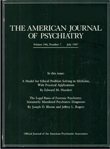Phenomenology of adolescent and adult mania in hospitalized patients with bipolar disorder
Abstract
OBJECTIVE: Although available data suggest that bipolar disorder most commonly begins in adolescence, it has often been underrecognized and misdiagnosed in this age group. The authors hypothesized that this might in part be because adolescent mania is phenomenologically different from adult mania. To test this hypothesis, they compared a cohort of adolescents hospitalized for acute mania with a group of hospitalized acutely manic adults. METHOD: The authors compared symptomatic differences between 40 adolescent (ages 12-18 years) and 88 adult (ages 19-45 years) bipolar patients hospitalized for acute mania. They also compared the two groups with respect to demographic characteristics, psychiatric comorbidity, family history, and short- term outcome. RESULTS: Compared with adults, adolescent patients displayed a significantly higher rate of mixed bipolar disorder and a significantly lower rate of psychotic features (by DSM-III-R criteria), as well as higher ratings for many depressive symptoms (including suicidality and depressed mood) and lower ratings for thought disorder and delusions. Adolescents also displayed a significantly lower rate of substance abuse and significantly higher rates of familial mood disorder and drug abuse or dependence. CONCLUSIONS: Significant differences were found in the phenomenology of adolescent and adult mania in this study. The reasons for these differences are not known. Possible explanations include artifact due to methodological limitations and differences between adolescents and adults in familial loading for mood or substance use disorders or in developmental or maturational stage.



